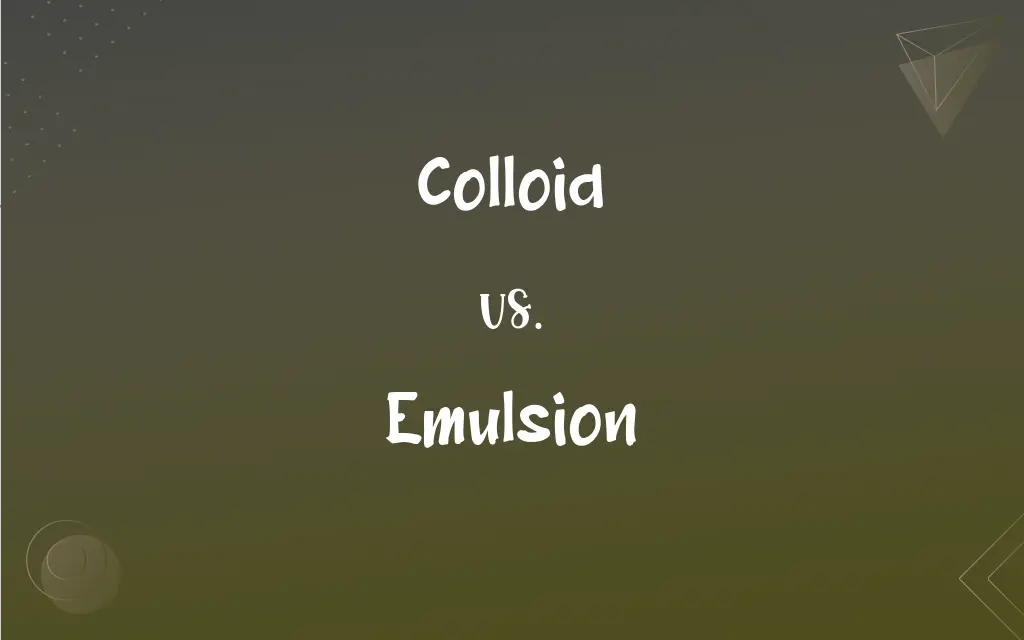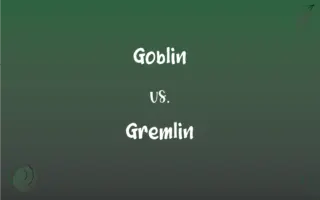Colloid vs. Emulsion: What's the Difference?
Edited by Aimie Carlson || By Janet White || Updated on October 6, 2023
A colloid is a mixture in which one substance is dispersed evenly throughout another, while an emulsion is a specific type of colloid where both substances are liquids.

Key Differences
Colloid and Emulsion both refer to mixtures of substances, but they serve different specifics.
A colloid is a general term for any mixture in which one substance is divided into small particles and dispersed throughout another substance. These mixtures can include solids, liquids, and gases in various combinations.
For instance, milk is a colloid because it contains butterfat particles spread throughout a watery solution. Emulsion, on the other hand, is a more specific term. It describes a colloid in which both substances involved are liquids. Typically, these two liquids don't mix well, like oil and water. When these two are mixed and become an emulsion, small droplets of one liquid spread throughout the other. Mayonnaise, for instance, is an emulsion made from oil and vinegar, among other ingredients.
Thus, while all emulsions are colloids, not all colloids are emulsions.
The importance of understanding the distinction between colloid and emulsion often comes to the fore in fields such as food science, chemistry, and pharmacology. While the former is a broad categorization of mixtures, the latter delves into the specific interaction between two liquid phases.
ADVERTISEMENT
Comparison Chart
Definition
Mixture with particles dispersed in another phase
Specific colloid with both phases being liquid
Examples
Fog, gel, milk
Mayonnaise, milk, vinaigrette
Components
Can be solid, liquid, or gas
Always involves two immiscible liquids
Stability
Can be stable or unstable
Often requires stabilizers to prevent separation
Particle Size
Typically between 1 nm and 1 μm
Similar to colloids but specific to liquid-liquid
ADVERTISEMENT
Colloid and Emulsion Definitions
Colloid
A system in which particles are dispersed in a continuous phase of a different composition.
Whipped cream is a colloid with air dispersed in cream.
Emulsion
A fine dispersion of minute droplets of one liquid in another in which it is not soluble.
Vinaigrettes are emulsions of oil in vinegar.
Colloid
A substance microscopically dispersed throughout another substance.
Butter is a water-in-fat colloid.
Emulsion
Two immiscible liquids mixed together, typically with the aid of an emulsifying agent.
Mayonnaise is an oil-in-water emulsion stabilized by egg yolk.
Colloid
A heterogeneous mixture with particle size between a solution and a suspension.
Milk is a colloid of fat particles in water.
Emulsion
A liquid mixture that contains small globules of another liquid.
A photographic film contains an emulsion of light-sensitive compounds.
Colloid
A mixture that doesn't settle or separate.
Gelatin desserts are colloids that remain consistent.
Emulsion
A colloidal system in which both phases are liquids.
Cream is an emulsion of fat droplets in water.
Colloid
A system in which finely divided particles, which are approximately 1 to 1,000 millimicrons in size, are dispersed within a continuous medium in a manner that prevents them from being filtered easily or settled rapidly.
Emulsion
A suspension of small globules of one liquid in a second liquid with which the first will not mix
An emulsion of oil in vinegar.
Colloid
The particulate matter so dispersed.
Emulsion
A photosensitive coating, usually of silver halide grains in a thin gelatin layer, on photographic film, paper, or glass.
Colloid
The gelatinous stored secretion of the thyroid gland, consisting mainly of thyroglobulin.
Emulsion
A stable suspension of small droplets of one liquid in another with which it is immiscible.
Mayonnaise is an emulsion where egg is used to keep oil and water mixed.
Colloid
Gelatinous material resulting from degeneration in diseased tissue.
Emulsion
(chemistry) A colloid in which both phases are liquid.
Colloid
Of, relating to, containing, or having the nature of a colloid.
Emulsion
(photography) The coating of photosensitive silver halide grains in a thin gelatine layer on a photographic film.
Colloid
Glue-like; gelatinous.
Colloid tumours
Emulsion
Any liquid preparation of a color and consistency resembling milk; as: (a) In pharmacy, an extract of seeds, or a mixture of oil and water united by a mucilaginous substance. (b) In photography, a liquid preparation of collodion holding salt of silver, used in the photographic process.
Colloid
(chemistry) A stable system of two phases, one of which is dispersed in the other in the form of very small droplets or particles.
Emulsion
(chemistry) a colloid in which both phases are liquids;
An oil-in-water emulsion
Colloid
(meteorology) An intimate mixture of two substances, one of which, called the dispersed phase (or colloid), is uniformly distributed in a finely divided state throughout the second substance, called the dispersion medium (or dispersing medium).
Emulsion
A light-sensitive coating on paper or film; consists of fine grains of silver bromide suspended in a gelatin
Colloid
(geology) A particle less than 1 micron in diameter, following the Wentworth scale
Emulsion
A stable suspension of one liquid in another with which it is immiscible.
Some skincare products are water-in-oil emulsions.
Colloid
Resembling glue or jelly; characterized by a jellylike appearance; gelatinous; as, colloid tumors.
Colloid
A substance (as albumin, gum, gelatin, etc.) which is of a gelatinous rather than a crystalline nature, and which diffuses itself through animal membranes or vegetable parchment more slowly than crystalloids do; - opposed to crystalloid.
Colloid
A gelatinous substance found in colloid degeneration and colloid cancer.
Colloid
A mixture with properties between those of a solution and fine suspension
Colloid
Material composed of very fine particles suspended in another medium.
Fog is a colloid of water droplets in air.
FAQs
What's the primary difference between colloid and emulsion?
Emulsion is a colloid where both substances are liquids.
Can gases be involved in colloids?
Yes, gases can be dispersed in colloidal systems, like fog.
Is milk an emulsion or colloid?
Milk is both: it's a colloid with an emulsion of fat in water.
Can you turn an emulsion into a non-emulsion?
Yes, by causing it to separate or break.
Are gels considered colloids?
Yes, gels are a type of colloid.
Are all emulsions colloids?
Yes, all emulsions are a type of colloid.
Do emulsions always require an emulsifying agent?
Not always, but many do to maintain stability.
Can colloids be seen with the naked eye?
Often, colloidal particles are too small to be seen individually but can scatter light.
What happens when an emulsion breaks?
The two liquids separate into distinct layers.
Is mayonnaise an emulsion?
Yes, it's an oil-in-water emulsion.
How are emulsions used in paints?
Water-based paints often have pigment particles dispersed in an emulsion.
Can emulsions be found in pharmaceuticals?
Yes, some drug formulations are emulsions.
Why is homogenization used in milk processing?
To break fat into smaller droplets, creating a stable emulsion.
Why do some emulsions separate over time?
Without stabilizers, the immiscible liquids might separate due to their differing properties.
What's a real-world example of a colloid?
Smoke is a colloid of solid particles in gas.
What keeps the particles suspended in a colloid?
Brownian motion and charge distribution prevent settling.
What role does particle size play in colloids?
Particle size affects dispersion, stability, and light-scattering properties.
Are colloids always liquid-based?
No, they can involve solids, liquids, and gases.
Why is understanding colloids important in food science?
Many foods are colloidal systems, affecting texture and stability.
Can emulsions be oil-in-oil?
Typically no, emulsions involve two immiscible liquids.
About Author
Written by
Janet WhiteJanet White has been an esteemed writer and blogger for Difference Wiki. Holding a Master's degree in Science and Medical Journalism from the prestigious Boston University, she has consistently demonstrated her expertise and passion for her field. When she's not immersed in her work, Janet relishes her time exercising, delving into a good book, and cherishing moments with friends and family.
Edited by
Aimie CarlsonAimie Carlson, holding a master's degree in English literature, is a fervent English language enthusiast. She lends her writing talents to Difference Wiki, a prominent website that specializes in comparisons, offering readers insightful analyses that both captivate and inform.































































